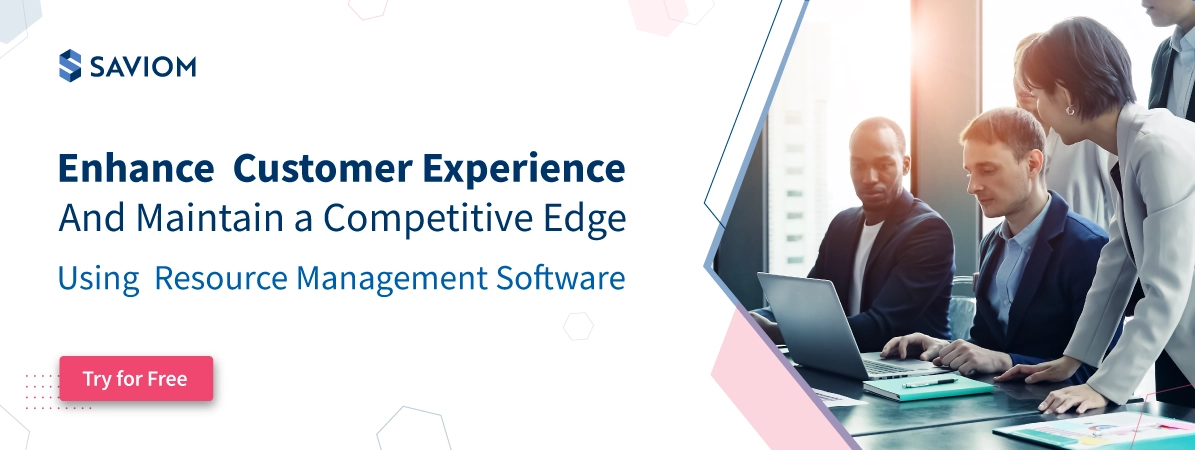“Customer is the king.” Indeed, this adage holds true for every business regardless of the industry it belongs to.
Therefore, organizations today are implementing myriad ways to enhance customer experience. It depends on several factors such as the marketing strategy, brand awareness, product/service quality, value proposition, etc.
Since employees are responsible for timely deliverables, it’s a no-brainer that customer experience vastly depends on how efficiently a company manages its workforce. That’s because the extent to which a company taps into the potential of its talent pool decides the product or service quality.
In simple words,
Effective resource management forms one of the cornerstones of a great customer experience.
This blog elaborates on the various factors that determine customer experience, key metrics to measure the same, and how resource management plays a key role in its enhancement.
But first, let’s understand:
Why does customer experience (CX) matter?
In the words of Sam Walton, an American entrepreneur and the founder of Walmart, “There’s only one boss, the customer.”
The satisfied customers spread good word-of-mouth about the firm and promote your brand enthusiastically. In turn, it leads to an increase in the overall business revenue and profitability. Moreover, their testimonials and experience elevate your credibility in the hyper-competitive world. So, every organization must leave no stone unturned to enhance the customer experience.
Factors that affect customer experience:
Customer experience depends on a number of factors. Some prominent ones are:
- Product/Service quality –
Your product/service quality has a direct influence on how customers perceive your brand. A good quality product/service contributes to your customers’ satisfaction levels and adds to their loyalty.
- Response time –
In the consumer-driven world, customers expect queries to be answered or addressed instantly. So, companies use several channels, including live chat, chatbots, FAQs, etc., to address redundant queries. This response time is directly proportional to the customer experience, that is, a faster response time translates to a better experience.
- Competitive pricing –
The strategic pricing for your product or service or the right value against the price makes the customer choose you over other competitors in the market.
- Feedback responses –
Customers may post their feedback and reviews on your company’s site, social media handles, open forums, etc. Analyzing and replying to reviews, especially the negative ones, tactically helps retain trust and good relations with customers.
- Company’s workforce –
A workforce well-equipped with competent skills and certifications can understand and cater to customers’ needs and demands more efficiently. They can regularly upskill themselves and implement their expertise to upgrade the products/services and meet the evolving demands. It helps them maintain a competitive edge, thus enriching the customer experience.
Key metrics to measure customer experience
One can assess customer experience by tracking tangible and intangible KPIs or metrics. Below are a few of them.
- Customer reviews –
Your customers’ reviews on various social media channels, forums, or your site directly reflect how they discern your brand and give a reality-check of their experience.
- Net promoter score –
Net Promoter Score (NPS) is a metric used to measure customers’ loyalty. It is calculated using a survey with a single question, “How likely will you recommend an X product/Y service to your friends or relatives?”.
Net promoter score is calculated as the percentage of detractors subtracted from that of promoters, and the higher value represents a better customer experience. On a scale of 1-10, respondents can be categorized into three categories, where those responding with:
- 9 and 10 are promoters who are loyal customers and will keep buying and recommending your brand to others.
- 7 and 8 are passives who are satisfied but unenthusiastic and may switch to competitive offerings.
- Below 7 are detractors who are highly dissatisfied and may spread bad word-of-mouth affecting your reputation and growth.
- Customer retention rate –
It is defined as the percentage of customers who continue doing business with your company over a given period. A higher value of CRR represents better CX.
- Annual recurring revenue –
It is defined as the revenue expected to be generated from repeat customers annually. As a tangible metric to gauge customer experience, its value reflects that your product/service has the potential to keep your customers choosing you over others.
- Customer satisfaction rate (CSAT) –
CSAT measures a customer’s satisfaction on a percentage scale for a particular product/service. On this scale, the higher the percentage, the higher is the customer satisfaction level.
One can work on these KPIs and enhance their values by managing the workforce intelligently.
Let’s understand how.
How value-driven resource management can help enhance customer experience?
From ensuring successful project delivery to aligning sales with delivery, resource management contributes to the customer experience in multiple ways.
The prominent and the most effective ones are mentioned below,
Ensures timely project delivery with proactive planning
When the project demands are not fulfilled on time, it can cause last-minute firefighting for resources. Additionally, it can delay the project’s timeline and lead to escalated costs, wrongful hiring, etc. All these practices lead to sub-optimal deliverable quality and budget and schedule overruns.
Since a client’s primary emphasis is on time, budget, and quality, delayed or reactive planning can mar their experience. Managers can avoid this by staying forewarned of the current and future resource demands and fulfilling them with appropriate resourcing measures. Using the resource management software, they can view the demand on a centralized platform, analyze the skills gap and bridge it using capacity planning, and proactively build a resource plan.
Read More: Project Resource Management: An Ultimate Guide on How to Master it
Enhances client satisfaction by eliminating scheduling conflicts
In a multi-project environment, skill requirements and timelines may often clash, causing scheduling conflicts. If not handled strategically, one or the other project might suffer. As every customer considers their project valuable, they may find another vendor if their project faces a setback due to resource shortage/unavailability.
A resource management solution provides a multidimensional view of the project and resource schedules. So,
If two projects require a similar skilled resource, managers can gauge the ongoing project’s progress, and if it has attained a steady state, they can out-rotate the employee.
They can then fill vacancies in the ongoing project with appropriate backfills without disrupting its progress. This will ensure all the projects go on without any bottlenecks, ascertaining the client’s satisfaction.
Maintains project quality with competent resource allocation
A project’s quality relies on the expertise and competencies of the team members working on it. However, if partially skilled or incompetent resources are allocated, it will directly compromise the quality. This will lower the client’s satisfaction (CSAT), ARR, etc. Managers can prevent this by implementing a resource management solution.
It provides enterprise-wide visibility of resources that helps filter the right resource for the right job by sorting them through various criteria, including skill, department, role, competency level, costs, etc., ensuring competent allocation. They can also initiate planned or project-specific hiring, upskilling/training measures, etc., to prepare the workforce for upcoming roles and requirements.
Read More: Resource Allocation: A Guide on How to Apply it to Project Management
Boosts project performance by optimizing resource distribution
Failure to track and optimize resources’ schedules before assigning them to a project can cause uneven workload distribution, leading to overutilization. It can cause employee burnout and negatively influence their productivity and performance. This sub-optimal performance can negatively impact the quality of products/services delivered, cause delays, thus hampering the customer experience.
A resource management tool provides a comprehensive view of every team member’s utilization level via a color-coded heatmap. It helps managers identify over/underutilized resources, take appropriate corrective measures, and enhance project performance. Further, forecast-vs-actual time reports help determine whether a given resource takes more or less time than estimated to complete a task. Accordingly, the managers can minimize these variances and bring the project back on track, ensuring a remarkable consumer experience.
Maintains alignment of sales with delivery
A lack of communication between the sales and delivery teams can negatively affect project delivery. That’s because if the sales team fails to communicate the requirements to the delivery team and get feasibility validation, they may over-commit to the client. If the deliverables aren’t up to the mark, it will jeopardize the brand’s reputation, leading to lost market opportunities and a decrease in customer retention rates.
A resource management solution provides visibility into pipeline projects that reach a certain probable stage. It enables the delivery team to analyze every project’s type, complexity, objective, skills requirement, etc., and determine its viability. If the project is aligned strategically and the firm has the required personnel, the delivery team can give a ‘go’ decision and execute the project meeting the quality standards. Eventually, it will enhance the customer’s trust in your firm and lead to a long-term association.
Read More: 4 steps to perfect your Project Pipeline Management strategy
Ensures project delivery within budget using actionable insights
Budget is one of the major aspects that define a client’s experience. In the event of incorrect budget estimation by project managers who may overlook certain attributes, it may result in cost overruns, decreased profitability, and in worse cases, lead to a project halt. All these factors collectively have an adverse effect on client experience.
A resource management tool provides real-time forecast-vs-actual budget and revenue reports. These reports help the project manager keep track of financials and identify any large-scale variance from the predefined budget or revenue. For example, a client requests some additional features to be added to the product during the development phase. In this case, the project manager can check the feasibility of those features and determine whether they would exceed the budget. They can accordingly negotiate with the clients with clarity and secure the client-vendor relationship.
Helps meet evolving skill demands by future-proofing the workforce
Every day, new trends are emerging and reshaping almost every industry. As a result, the customers’ requirements and demands are continuously evolving as they are looking for the latest and cutting-edge products/services. So,
Every company should ensure that its workforce is well-equipped with adequate competencies and skills to align its products/services with the latest trends and enhance the customer experience.
A resource management solution helps look into the upcoming projects’ skill demands. Accordingly, they can implement upskilling/reskilling programs to bridge the skill gaps and future-proof the workforce to accomplish future projects. It will help the organization maintain a competitive edge and out-stand in the market. Moreover, by staying abreast of the latest technology and trends, companies can stay future-ready to cater to advanced projects and evolving customers’ demands.
Read More: How Can Retraining/Upskilling Future-Proof Your Workforce?
Additional tips to enhance customer experience
As customer experience is the everlasting impression, your brand leaves on through the various stages of a buyer’s journey, making it top-notch is indispensable. While efficient resource management is undoubtedly a game-changer, you can follow a few more tips to enhance the customer experience.
- Use a personalized email or message to engage with different customers.
- Leverage an omnichannel marketing strategy to engage and acquire customers across various channels, online and offline.
- Implement loyalty programs and offers for customers. It will secure a good retention rate.
- Conduct regular feedback surveys and implement feasible suggestions to make customers feel valued and enhance their experience.
What is your customer retention strategy?
The Glossary
Read More: Glossary of Resource Workforce Planning, Scheduling and Management
The SAVIOM Solution
SAVIOM is the market leader in helping multinational clients manage their resources efficiently and effectively. With over 20 years of experience, this Australian-based MNC has a global presence across 50 countries and has helped 100+ clients with their Workforce Planning Software. Saviom also provides tools for Enterprise Project Resource Management, Project Portfolio Management, and Professional Service Automation. Boost your remote team collaboration with Saviom.












